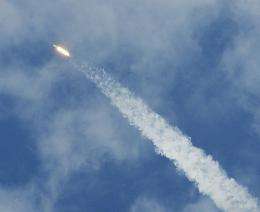The Space X Falcon 9 rocket heads for space in June 2010 in Florida, on its first test flight. American company SpaceX will attempt Thursday to launch its first space capsule into orbit and back, in a key test for the future of commercial space flight as NASA winds down its shuttle program.
An American company may attempt to launch its first space capsule into orbit as early as Wednesday, in a key test for the future of commercial space flight as NASA winds down its shuttle program.
The Dragon spacecraft, unnamed for now but designed with seats for seven and an ample cargo hold, aims to hurtle into orbit and then splash into the Pacific Ocean about four to five hours later, said the company, SpaceX.
The bullet-shaped space capsule, which could one day tote supplies to the International Space Station, is scheduled to blast off from Cape Canaveral in Florida.
The launch was postponed Monday after engineers found a three-inch (eight-centimeter) crack in the engine nozzle of the Falcon 9 rocket that was to carry the Dragon space capsule, NASA said.
"SpaceX is considering several options, including repairing the crack or shipping a replacement part from California. More information on the launch schedule will be announced when available," NASA said.
Earlier, SpaceX president Gwynne Shotwell said the launch -- originally due for liftoff on Tuesday -- was delayed, possibly until Thursday, due to "porosity and potentially cracking in a weld joint."
The operation hopes to showcase the capsule's ability to launch and separate from the Falcon 9 rocket, orbit Earth, transmit signals and receive commands, and then re-enter the Earth's atmosphere for an ocean recovery.
Never before has a non-government owned spacecraft successfully pulled off such a feat, and the operation carries significant risks.
The craft must namely maneuver in orbit at speeds of more than 17,000 miles (27,360 kilometers) per hour, survive a fiery re-entry into orbit and manage a safe parachute landing into the ocean.
SpaceX said the Dragon, which has no wings unlike the space shuttles, will control its re-entry through "onboard Draco thrusters, which enable the spacecraft to touchdown at a very precise location -- ultimately within a few hundred yards (meters) of its target."
In late November, the Federal Aviation Administration issued its first license to SpaceX to permit a privately-owned spacecraft to re-enter Earth's orbit.
A previous flight by the world's first commercial spaceship, owned by Virgin Galactic's Richard Branson, made its first piloted journey in October but stayed close to its California base and did not enter orbit.
If the Dragon launch is successful, the next steps are for a fly-by of the ISS as part of a five-day mission in which the Dragon will approach the orbiting station within six miles (10 kilometers), and later an actual cargo and crew mission to the ISS.
Both are scheduled to take place in 2011.
As tall as an 18-story building, the Falcon 9 rocket that will carry the Dragon was successfully test launched in June.
The US space agency NASA signed a 1.6-billion-dollar contract with SpaceX in December 2008 under the Commercial Orbital Transportation Services (COTS) program to provide 12 spacecraft with cargo capacity of at least 20 tonnes to resupply the International Space Station (ISS) through 2016.
NASA has also signed a contract of 1.9 billion dollars with Orbital Space Corporation for eight launches of its Taurus II rocket starting in 2011.
President Barack Obama hopes the private sector will help fill the gap that will open when the space shuttle fleet is retired next year, and before a new generation of spacecraft is developed.
The three US shuttles -- Discovery, Atlantis and Endeavour -- will become museum pieces after a final shuttle mission to the space station in 2011.
Obama has proposed spending six billion dollars over five years to help the private sector develop reliable and affordable launchers to transport cargo and US astronauts to the International Space Station.
During the transition period, the United States will depend on Russian Soyuz rockets for access to the ISS.
(c) 2010 AFP




















